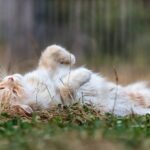Have you ever caught your cat doing something so unexpected, so heartwarming, that it made you wonder just how deeply they feel? The truth is, our feline friends are remarkably sensitive and capable of emotional development. Whether it’s a hesitant paw reaching out for comfort or a sudden burst of confidence, cats reveal their emotional growth in the most surprising ways. For every cat lover who has wondered what goes on behind those mesmerizing eyes, here are ten feline reactions that speak volumes about their journey toward emotional maturity. Get ready to see your whiskered companion in a whole new light!
Seeking Out Physical Affection

When a cat begins to actively seek out cuddles or lap time, it’s a powerful sign of trust and emotional growth. Some cats start life wary of touch, shrinking away or hiding at the slightest movement. As they mature emotionally, a once-distant feline might curl up on your chest or nudge your hand for pets. This shift isn’t just adorable—it’s a testament to the bond you’ve built together. You may notice your cat choosing to sleep beside you, leaning into your touch, or following you from room to room. These are all clear signs your cat feels safe and connected. It’s their way of saying, “I trust you.” Each gentle head-butt or quiet purr is a milestone in their emotional journey.
Responding Calmly to New Situations

Kittens and anxious cats often react with wide-eyed fear to anything new: a strange visitor, a moving box, or even a different scent. But as they grow emotionally, their reactions change. You might see your cat investigating new objects with curiosity instead of bolting under the bed. They may watch from a distance at first, but soon enough, their tail will relax and their ears will perk up in interest rather than fear. This calm approach is a sign they’re learning to handle change with greater confidence. It shows resilience and adaptability, which are huge steps in feline emotional development. A cat who can calmly explore the unknown is a cat learning the world isn’t so scary after all.
Engaging in Playful Behavior

A playful cat is a happy cat, but did you know that playfulness often signals emotional growth? Cats who feel insecure or stressed rarely play, instead opting to hide or act defensively. When your feline starts chasing toys, pouncing on shadows, or initiating play with you, it’s more than just entertainment. It’s an expression of joy and comfort in their environment. Watch for spontaneous games, such as sudden sprints across the living room, or the classic “attack the invisible monster under the couch.” Play is how cats process their emotions, release energy, and even bond with their humans. Increased playfulness means they feel safe enough to let their guard down.
Demonstrating Gentle Curiosity

Have you noticed your cat gently approaching new people or objects with slow, deliberate steps rather than panicked dashes? This gentle curiosity is a hallmark of emotional growth. Instead of immediately running away, a cat may sniff a visitor’s shoe, observe from a few feet away, or cautiously tap a new toy. These small acts show a willingness to learn and adapt, rather than simply react. It’s as if your cat is saying, “I want to understand, not just survive.” This kind of measured exploration is a sign that your cat is growing emotionally and feeling more secure in their world.
Vocalizing in Meaningful Ways

Cats communicate a lot through their voices, but not all meows are equal. As cats mature emotionally, their vocalizations often become more nuanced and intentional. You might hear softer, more conversational meows when your cat is content, or specific sounds when they seek attention. Some even develop a unique “chirp” or trill just for their favorite humans. A cat that meows to greet you, “talks” as you prepare food, or purrs loudly during petting is expressing their feelings confidently. These sounds are more than just noise—they’re a form of connection and a sign of emotional openness.
Displaying Patience and Tolerance

A kitten or anxious cat may react quickly with swats or hissing when startled. Over time, emotionally mature cats learn patience and tolerance. Maybe your cat tolerates gentle grooming, remains calm when handled by the vet, or simply sits quietly during family chaos. This ability to remain composed rather than lashing out shows they’re learning to manage stress and trust their surroundings. It’s a huge leap from the days of constant hiding or defensive behavior. Watching your cat patiently endure a toddler’s gentle touch or calmly observing a new pet in the house is a sure sign of emotional growth.
Seeking Solace in Their Human

Sometimes, the most touching moments are when a cat chooses to seek comfort from you during stressful times. Maybe there’s a thunderstorm, or perhaps loud noises from outside make your cat nervous. Instead of hiding, an emotionally developed cat might curl up on your lap or press against your side for reassurance. This shows a deep trust and emotional bond. They see you not just as a provider, but as a source of comfort and safety. Such moments are deeply rewarding for cat owners and signal a cat’s growing emotional resilience.
Allowing Vulnerability During Rest

Cats are naturally cautious animals, especially when it comes to sleeping. Only when they feel truly safe will they sleep in exposed positions—on their backs, belly up, or stretched out in the middle of the floor. If your cat dozes off in such vulnerable poses, it’s a clear sign of emotional security. They’re showing you, in the most literal way, “I trust you with my safety.” This vulnerability is a massive step for any feline and speaks to a deep level of emotional growth and trust within your home.
Initiating Social Interactions

An emotionally secure cat won’t just wait for you to make the first move. They’ll come to you with their own invitations—rubbing against your legs, hopping onto your lap, or even bringing you their favorite toy. This initiative goes beyond seeking food or comfort. It’s about choosing to connect and share moments together. These self-initiated interactions show that your cat values your company and feels confident enough to express their needs and affection.
Expressing Empathy and Support

Perhaps the most astonishing sign of feline emotional growth is when a cat shows empathy. Many cat owners have experienced moments when their pet seems to sense sadness or stress and responds with gentle purring, close cuddles, or even quiet presence. It’s as if, in their own mysterious way, cats can sense our emotions and offer comfort in return. This empathetic response is a sign of true emotional depth. It transforms the cat-human relationship into a genuine partnership, filled with understanding and mutual support.

Linnea is a born and bred Swede but spends as much time as possible in Cape Town, South Africa. This is mainly due to Cape Town’s extraordinary scenery, wildlife, and atmosphere (in other words, because Cape Town is heaven on earth.) That being said, Sweden’s majestic forests forever hold a special place in her heart. Linnea spends as much time as she can close to the ocean collecting sea shells or in the park admiring puppies.






